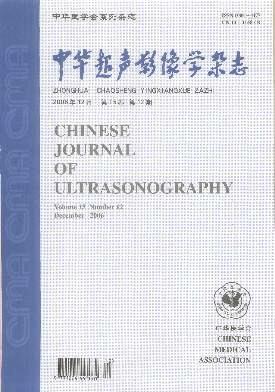Study on the characteristics of mitral annular displacement in middle and late pregnancy fetuses based on speckle tracking imaging
Q4 Medicine
引用次数: 0
Abstract
Objective To assess the longitudinal mitral annular plane systolic excursion (MAPSE) of different directions in normal fetuses during mid-late pregnancy based on two-dimensional speckle tracking imaging (STI). Methods Seventy-six normal fetuses during middle and late pregnancy were selected at 26-32 weeks of gestation. The peak MAPSE was measured by free angle M-mode echocardiography (FAM) perpendicular to the lateral annulus in the mitral annular plane. The time-displacement curves of interventricular septal mitral annulus in three different directions including points A, B and C through transverse level of apex were recorded by STI. The peak MAPSE of interventricular septal mitral annulus (SEPT-MAPSE-A, SEPT-MAPSE-B, SEPT-MAPSE-C) in three different directions including points A, B and C and the time to peak (TTP: SEPT-TTP-A, SEPT-TTP-B, SEPT-TTP-C) were recorded respectively. The time-displacement curves of lateral mitral annulus in three different directions including points A, B and C through transverse level of apex were recorded by STI. The peak MAPSE of lateral mitral annulus (LAT-MAPSE-A, LAT-MAPSE-B, LAT-MAPSE-C) in three different directions including points A, B and C, the time to peak(LAT-TTP-A, LAT-TTP-B, LAT-TTP-C) were recorded respectively. Finally, the data were analyzed statistically. Results The peak MAPSE of the lateral mitral annulus in 3 different directions including points A, B and C[LAT-MAPSE-A (3.62±1.01)mm, LAT-MAPSE-B (3.95±1.04)mm, LAT-MAPSE-C (4.45±1.05)mm] were greater than those of the interventricular septum mitral annulus[SEPT-MAPSE-A (3.41±0.63)mm, SEPT-MAPSE-B (3.07±0.50)mm, SEPT-MAPSE-C (2.82±0.51)mm]. LAT-MAPSE-C and SEPT-MAPSE-A were the largest longitudinal excursions of mitral annulus. The differences were statistically significant in points B and C (P 0.05). LAT-MAPSE-C was less than FAM-MAPSE[(6.06±1.35)mm]. There was a significant difference between them(P 0.05). There were no significant differences in time to peak of lateral mitral annulus[LAT-TTP-A(0.210±0.008)s, LAT-TTP-B(0.213±0.006)s, LAT-TTP-C(0.210±0.007)s] in directions inclucling points A, B, C(P>0.05). Conclusions Longitudinal systolic motion of fetal left ventricular wall during mid-late pregnancy has good synchronization. Longitudinal motion of fetal mitral annulus is a comprehensive movement of multiple directions and different degrees of displacement, with the movement perpendicular to the annulus as the maximum displacement direction. The displacement parameters of mitral annulus measured by STI can reflect the left ventricular longitudinal systolic function and have clinical application value in evaluating the left ventricular longitudinal systolic function of fetuses. Key words: Speckle tracking imaging; Fetus; Mid-late pregnancy; Mitral annular plane systolic excursion; Free angle M-mode echocardiography基于散斑跟踪成像的中晚期妊娠胎儿二尖瓣环移位特征研究
目的应用二维散斑跟踪成像(STI)评价妊娠中后期正常胎儿不同方向的纵向二尖瓣环平面收缩偏移(MAPSE)。方法选取妊娠26 ~ 32周的中晚期正常胎儿76例。在二尖瓣环平面垂直于侧环的自由角m型超声心动图(FAM)测量MAPSE峰值。用STI记录二尖瓣间隔环在A、B、C三个不同方向经尖横切面的时间位移曲线。分别记录室间隔二尖瓣环在A、B、C点三个不同方向的MAPSE峰(sep -MAPSE-A、sep -MAPSE-B、sep -MAPSE-C)及到达峰值的时间(TTP: sep -TTP-A、sep -TTP-B、sep -TTP-C)。用STI记录二尖瓣横向水平在A、B、C三个不同方向的二尖瓣外侧环时间位移曲线。分别记录二尖瓣外侧环在A、B、C三个不同方向的MAPSE峰(lata -MAPSE-A、latb -MAPSE-B、late -MAPSE-C)及峰值时间(lata - ttp -A、lata - ttp -B、latp -C)。最后对数据进行统计分析。结果侧二尖瓣环A、B、C点3个不同方向的MAPSE峰值[lata -MAPSE-A(3.62±1.01)mm, lata -MAPSE-B(3.95±1.04)mm, lata -MAPSE-C(4.45±1.05)mm]均高于室间隔二尖瓣环[SEPT-MAPSE-A(3.41±0.63)mm, SEPT-MAPSE-B(3.07±0.50)mm, SEPT-MAPSE-C(2.82±0.51)mm]。latt - mapse - c和SEPT-MAPSE-A是二尖瓣环纵向偏移最大的。B、C点差异有统计学意义(P < 0.05)。lata - mapse - c小于FAM-MAPSE[(6.06±1.35)mm]。两组间差异有统计学意义(p0.05)。二尖瓣外侧环在A、B、C点上到达峰值的时间[latt - ttp -A(0.210±0.008)s, latt - ttp -B(0.213±0.006)s, latt - ttp -C(0.210±0.007)s]差异无统计学意义(P < 0.05)。结论妊娠中后期胎儿左室壁纵向收缩运动具有良好的同步性。胎儿二尖瓣环纵向运动是多方向、不同位移程度的综合运动,以垂直于二尖瓣环的运动为最大位移方向。STI测量的二尖瓣环位移参数能反映左室纵向收缩功能,对评价胎儿左室纵向收缩功能有临床应用价值。关键词:散斑跟踪成像;胎儿;怀孕中后期;二尖瓣环面收缩偏移;自由角度m型超声心动图
本文章由计算机程序翻译,如有差异,请以英文原文为准。
求助全文
约1分钟内获得全文
求助全文
来源期刊

中华超声影像学杂志
Medicine-Radiology, Nuclear Medicine and Imaging
CiteScore
0.80
自引率
0.00%
发文量
9126
期刊介绍:
 求助内容:
求助内容: 应助结果提醒方式:
应助结果提醒方式:


